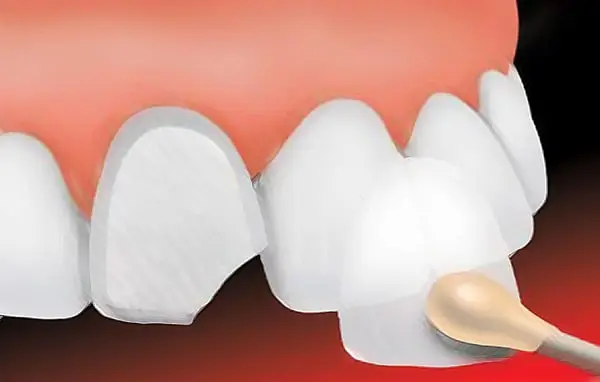What is the Best Dental Veneer Material for You?
What is the Best Dental Veneer Material for You?
Now, the veneers are a product that comes in different types and materials. When your dentist uses veneers, they usually can give you a new look in only two appointments. In the first visit, the teeth are prepared for the veneers. This is a simple process that usually involves removing about half a millimeter of enamel from the tooth surface, which is an amount nearly equal to the thickness of the veneer to be added to the tooth surface. The tooth is then shaped in a manner that will allow for the veneer to be bonded to it and will look pleasing to the overall structure of the mouth. The dentist will then make an impression of your teeth and send this off to the lab so that the veneer can be constructed. This process usually takes about one to two weeks. If the teeth are unsightly and the patient would prefer not to wait one to two weeks with the unattractive teeth, temporary veneers can be placed for that short period of time. In the second visit, the dentist will bond the veneers to the teeth with various bonding agents. The veneers are then adjusted for the proper comfort and look of the mouth.
What are veneers and what’s the concept behind veneering?
A dental veneer is a thin shell of tooth-colored material. They are custom-made and bonded to the front of the tooth to enhance the appearance of chipped or discolored teeth. The concept of veneering is to invasively or non-invasively cover the facial surface of the tooth to restore its shape and/or to enhance aesthetics. These facings are made of porcelain or composite and are adhesively bonded to the tooth. Porcelain has become the material of choice for veneers. It is strong, durable, and the most aesthetically pleasing material. Porcelain veneers resist stains and better mimic the light reflecting properties of natural teeth. It is often the material of choice for essential prosthodontics because it has a higher compressive strength than that of composite resin. A definitive diagnosis is established as to whether a patient is an ideal candidate for veneers, and informed consent is mandatory in order for treatment to commence. If a patient is prone to bruxism and/or parafunctional habits, a clear retainer must be worn to prevent chipping or fracturing of these thin veneers.
Knowing The Veneer Material To Choose: What’s In It For You?
Overall, for durability and longevity, there is no denying that porcelain is the best option for veneers. With the depth and translucency that porcelain veneers provide, this can usually simulate the light reflecting properties of natural teeth better than any other material. The strength of porcelain is also highly advantageous, lasting well over 10 years. When you compare the long-term cost and effect of other veneers, porcelain is actually more cost efficient in the long run. One of the best ways to conserve your natural teeth – as they are meant to last a lifetime – is by choosing a resin veneer. This process is less damaging to your teeth, as the dentist will remove less of the tooth surface before placing the veneer. Resin veneers are also ideal for people who clench or grind their teeth, as they are more durable in opposing porcelain. Although resin veneers may not be the number one choice aesthetically, for the money and the preservation of your natural teeth, they are tough to beat.

The Different Dental Veneer Material Types
a. Resin
Resin veneers may be directly fabricated inside the patient’s mouth or indirectly fabricated by a dental technician in a dental laboratory, depending on the patient’s case and the capabilities of their dentist. The direct technique typically involves the application of a composite material which is built up inside the mouth and hardened with a light curing process on one visit to fabricate a veneer. The indirect technique can involve fabricating the veneer with a type of composite material. This is done by making an impression of the patient’s teeth and then sending it to a laboratory to fabricate the veneer. The veneer can then be bonded to the tooth at a separate visit. Resin veneers are more cost effective to fabricate than porcelain veneers. This is because the material cost is less, and the setting times are faster. A significant detriment to resin veneers is their propensity to become stained. Due to this, resin veneers do not typically have the staying power of porcelain veneers.
b. Porcelain
One of the primary benefits of porcelain veneers is their stain resistance. With porcelain veneers, it is possible to achieve a stain-resistant surface with the use of a high-quality finishing polish. With a financial investment, it is also possible to obtain a higher quality polishing from your dentist, bringing an even higher likelihood of preventing any future staining. Additionally, the hardness and rigidity of porcelain is beneficial to its durability. When bonded to a healthy tooth, the porcelain veneer is actually stronger than natural tooth enamel. The manner in which porcelain reflects light is also superior to resin, and very similar to our natural teeth. An experienced ceramic artist can also manipulate the porcelain’s translucency in a way that is only possible by using various porcelain firing techniques. This can add great depth to a veneer and can make a prosthetic tooth nearly indistinguishable from a natural.
There are many different types of materials that have been used to fabricate veneers. They include porcelain, composite resin, ceramic, and a newer material which incorporates a technology of light-curing the resin, setting it more quickly and with less residual material.
Dental Porcelain & Ceramic Veneers
As for porcelain veneers, they are widely acknowledged as the most successful way to enhance a tooth’s appearance. The veneer is no longer seen as a second-class restoration. The recent popularity and availability of porcelain veneers have allowed dentists to have a predictable way to enhance the look of one’s smile. Also, when the veneer is made from the correct type of porcelain, the result is not only a beautiful and natural-looking smile but also a long-lasting change of appearance. Typically, a porcelain veneer is what most dental patients are looking for when they want to truly improve their smile and look good in the long run. With the consistent improvement of materials and laboratory techniques, a porcelain veneer can truly mimic the light-reflecting properties of a natural tooth. This means a dull-looking tooth can be vastly improved, as well as a discolored, mildly crooked, or spaced smile. Although they rarely chip, it’s still not a great idea to open a beer bottle with your teeth and avoid biting your fingernails. A porcelain veneer can also be cemented to a damaged or discolored tooth that has received endodontic treatment. This will ensure a protecting cap for one’s tooth or a way to improve the cosmetic appearance of a discolored endodontically treated tooth. Typically, a veneer is a more conservative choice than a full coverage crown. A dentist who suggests a crown over a veneer in a situation when minimal tooth reduction is needed probably does not have adequate training in the field of cosmetic dentistry.
There are two types of materials used to fabricate a veneer: composite and dental porcelain. A composite veneer can be directly placed or made in a dental laboratory and later bonded to the tooth. Generally, a composite veneer is a resin that is glued onto the tooth. It is simple and can be done in one office visit. This type of veneer does have its advantages. The main advantage is its preparation. Little or no tooth reduction is needed with a composite type of veneer. On the other hand, because they are made from resin, the result is a veneer that is thicker, larger, and less lifelike than one made of porcelain. Also, the color does not last nearly as long.

